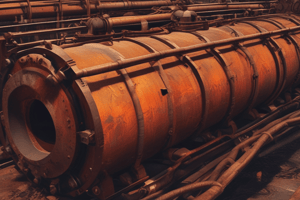Podcast
Questions and Answers
What is the primary function of barrier coatings in preventing corrosion?
What is the primary function of barrier coatings in preventing corrosion?
- To protect the metal surface from corrosive electrochemical charge (correct)
- To provide thermal insulation for metal components
- To promote oxidation reactions on the metal surface
- To enhance the aesthetic appearance of metal surfaces
In cathodic protection, which statement about the roles of metals is correct?
In cathodic protection, which statement about the roles of metals is correct?
- Both metals serve as cathodes to equally share the load of corrosion.
- The more reactive metal becomes the anode and iron becomes the cathode. (correct)
- It relies on using less reactive metals, like gold, for protection.
- Iron functions as the anode while a more reactive metal serves as the cathode.
What is the role of active radicals in the Advanced Oxidation Process during wastewater treatment?
What is the role of active radicals in the Advanced Oxidation Process during wastewater treatment?
- To enhance the temperature of the wastewater for effective treatment
- To convert pollutants into more complex molecules for easier analysis
- To break down complex molecules into simpler and less harmful substances (correct)
- To provide oxidizing agents that only target non-organic pollutants
Which coating layer primarily serves as a corrosion inhibitor in barrier coating systems?
Which coating layer primarily serves as a corrosion inhibitor in barrier coating systems?
Which metal is most commonly used in the electroplating process to prevent corrosion?
Which metal is most commonly used in the electroplating process to prevent corrosion?
What does an increase in oxidation number indicate during a redox reaction?
What does an increase in oxidation number indicate during a redox reaction?
Which statement correctly describes a substance that is oxidized?
Which statement correctly describes a substance that is oxidized?
In a redox reaction, the oxidizing agent is defined as the substance that:
In a redox reaction, the oxidizing agent is defined as the substance that:
What characterizes redox reactions?
What characterizes redox reactions?
Which of the following best defines a reduction reaction?
Which of the following best defines a reduction reaction?
Which is a correct identification of an oxidizing agent?
Which is a correct identification of an oxidizing agent?
What is the significance of oxidation in chemical reactions?
What is the significance of oxidation in chemical reactions?
Which of the following is NOT associated with reduction?
Which of the following is NOT associated with reduction?
What is the primary function of an electrochemical cell?
What is the primary function of an electrochemical cell?
In a galvanic cell, what occurs at the cathode?
In a galvanic cell, what occurs at the cathode?
What is the role of a salt bridge in a galvanic cell?
What is the role of a salt bridge in a galvanic cell?
Which statement accurately describes an electrolytic cell?
Which statement accurately describes an electrolytic cell?
What occurs during the process of electroplating?
What occurs during the process of electroplating?
How does corrosion relate to electrochemical processes?
How does corrosion relate to electrochemical processes?
What drives the flow of electrons in a galvanic cell?
What drives the flow of electrons in a galvanic cell?
What is an important characteristic of an electrolyte in an electrochemical cell?
What is an important characteristic of an electrolyte in an electrochemical cell?
Flashcards
Redox Reaction
Redox Reaction
A chemical reaction where oxidation and reduction happen simultaneously.
Oxidation
Oxidation
A process where a substance loses electrons, gains oxygen, loses hydrogen, or increases its oxidation state.
Reduction
Reduction
A process where a substance gains electrons, loses oxygen, gains hydrogen, or decreases its oxidation state.
Reducing Agent
Reducing Agent
Signup and view all the flashcards
Oxidizing Agent
Oxidizing Agent
Signup and view all the flashcards
Oxidation Number
Oxidation Number
Signup and view all the flashcards
What is the difference between oxidation and reduction?
What is the difference between oxidation and reduction?
Signup and view all the flashcards
Why are redox reactions important?
Why are redox reactions important?
Signup and view all the flashcards
Electrochemistry
Electrochemistry
Signup and view all the flashcards
Electrochemical Cell
Electrochemical Cell
Signup and view all the flashcards
Galvanic Cell
Galvanic Cell
Signup and view all the flashcards
Electrolytic Cell
Electrolytic Cell
Signup and view all the flashcards
Electroplating
Electroplating
Signup and view all the flashcards
Anode
Anode
Signup and view all the flashcards
Cathode
Cathode
Signup and view all the flashcards
Corrosion
Corrosion
Signup and view all the flashcards
Barrier Coating
Barrier Coating
Signup and view all the flashcards
Cathodic Protection
Cathodic Protection
Signup and view all the flashcards
Advanced Oxidation Process
Advanced Oxidation Process
Signup and view all the flashcards
Oxidation-Reduction Reaction
Oxidation-Reduction Reaction
Signup and view all the flashcards
Study Notes
Prayer Before Class
- Holy Spirit, the true source of wisdom and light, dispel darkness and ignorance.
- Grant a penetrating mind, a strong memory, and ease in learning.
- Guide the work, direct progress, and bring it to success.
- Ask through Jesus Christ, true God and man, for blessings, and His continued reign.
- Pray for God's grace and strength.
Post-Laboratory Discussion: Reduction-Oxidation Reactions
- This discussion is about Reduction-Oxidation Reactions in Chemistry for Engineers Laboratory at UST General Santos.
Learning Objectives
- Define and differentiate between oxidation and reduction reactions.
Outline
- Reduction-Oxidation Reactions
- Electrochemistry
- Galvanic Cell
- Electrolytic Cell
- Electrochemistry
Reduction-Oxidation Reaction
- A broad range of reactions involving simultaneous oxidation and reduction.
What is Redox Reaction?
- Chemical reactions involving simultaneous oxidation and reduction.
- Explained in terms of:
- Loss or gain of oxygen
- Loss or gain of hydrogen
- Transfer of electrons
- Changes in oxidation number
Redox Reaction - Electrons
- Increase in oxidation number = loss of electrons, oxidation has occurred.
- Decrease in oxidation number = gain of electrons, reduction has occurred.
Oxidation
- Originally described as combining oxygen with an element to form a new substance.
- A substance is oxidized if it gains oxygen, loses hydrogen, loses electrons, and increases its oxidation state after a reaction.
Reduction
- Initially described as removing oxygen from an oxygen-containing compound.
- A substance loses oxygen, gains hydrogen, gains electrons, and decreases its oxidation state after a reaction.
Difference Between Oxidation and Reduction
- Oxidation: gain of oxygen, loss of hydrogen, loss of electrons, increase in oxidation number.
- Reduction: loss of oxygen, gain of hydrogen, gain of electrons, decrease in oxidation number.
Redox Reaction
- Reducing agent: gives up electrons.
- Oxidizing agent: takes up electrons.
- Example: Zn + S → ZnS (Zn is the reducing agent, S is the oxidizing agent.)
Electrochemistry: Fruit Battery and Electroplating
- Study of transformations between chemical and electrical energy.
- Redox reactions occur through electrochemical cells.
Electrochemistry
- Field of chemistry involving studying the transformation of chemical energy to electrical energy.
- Reactions occurring are redox reactions.
- Occur through the use of electrochemical cells.
Electrochemical Cell
- Device for converting chemical energy in redox reactions into electrical energy and vice versa.
- Two types:
- Galvanic cell
- Electrolytic cell
Electrochemical Cell (continued)
- All electrochemical cells share common features:
- Two electrodes (anode and cathode)
- Electrodes submerged in an electrolyte (conductive solution)
- Electron transfer between oxidized and reduced substances.
Electrochemical Cell (continued)
- Cathode: positive terminal, reduction takes place, electrons move into the cathode.
- Anode: negative terminal, oxidation takes place, electrons move out of the anode.
Electrochemical Cell: Galvanic Cell
- Devices transferring electrons from reaction transfer through an external circuit.
- Uses a spontaneous redox reaction to generate electrical energy.
- Cathode (+): where reduction occurs.
- Anode (-): where oxidation occurs.
Galvanic Cell
- Circuit between half-cells connected by a salt bridge.
- Electrons flow from anode to cathode through a connecting wire.
- Driving force of electron flow = electrode potential (E).
Electrolytic Cell
- Using electrical energy to force a nonspontaneous chemical reaction to occur.
- Hooked up to a battery or power supply.
- Cathode is (-) and connected to the anode of the battery.
- Anode is (+) and connected to the cathode of the battery.
Galvanic vs. Electrolytic Cell
- Galvanic: spontaneous redox reactions generates electricity.
- Electrolytic: non-spontaneous reactions use electricity
Electroplating
- Coating one electrode with another metal.
- Electrolysis where electrodes play a major role in placing one metal over another.
Rust and Corrosion
- Galvanic process where metals deteriorate due to oxidation.
- Corrosion is the process of returning metal to its natural ore state.
- Metal oxidized, losing structural integrity.
Rust and Corrosion (continued)
- Iron hydroxide forms & is quickly oxidized.
- Cathode action reduces oxygen and forms hydroxide ions.
- Anode action causes pitting of the iron.
How to Prevent Corrosion
- Barrier Coating: uses coatings like paint or plastics to prevent electrochemical charge.
- Electroplating: electrodeposition of a metal on a steel or iron surface (zinc is common)
- Cathodic protection: use of a more reactive metal than iron to protect it from oxidation.
Oxidation Reactions
- Advanced oxidation processes (AOPs) involve wastewater treatment to produce active radicals that degrade pollutants.
- AOPs break down complex pollutants into simpler, less harmful substances.
Prayer After Class
- Grant a mind to know God, a heart to seek wisdom, and a conduct pleasing to God.
- Express faithful perseverance in waiting for and finally embracing God.
Studying That Suits You
Use AI to generate personalized quizzes and flashcards to suit your learning preferences.




